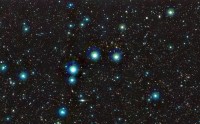Looking deep into the cosmos

A team led by University of Edinburgh astrophysicist Professor James Dunlop has released the most sensitive ever infrared image of a representative region of the distant Universe.
The new image comes from the first year of data taken as part of the five-year UltraVISTA survey. It was made by combining more than six thousand separate exposures equivalent to an exposure time of 55 hours. The image reveals more than 200,000 galaxies, including the most massive galaxies yet seen in the early Universe, objects which formed less than one billion years after the Big Bang.
Commenting on these revolutionary new images, Prof Dunlop said: "Until recently our view back to the first epoch of galaxy formation has been limited to tiny, "pencil-beam" images made with the Hubble Space Telescope. Now VISTA, with its panoramic imaging capability, is providing us with the first view of truly representative regions of the young Universe. This image is just a first taste of what the UltraVISTA survey will ultimately provide."
"UK astronomers can be very proud of this achievement. Until the launch of the James Webb Space Telescope, UltraVISTA gives us the best view we will have of the large-scale distribution of the earliest galaxies." Prof John Peacock, Head of the University of Edinburgh's Institute for Astronomy.
The UltraVISTA survey area co-incides with the location of the largest optical image taken with the Hubble Space Telescope, termed the COSMOS survey. The combination of the existing Hubble optical imaging and the new VISTA near-infrared data provides a treasure trove for a wide range of astronomical studies. The final UltraVISTA image is expected to reveal objects 5-10 times fainter still, enabling the study of galaxy evolution over essentially all of cosmic time.
The image combines exposures taken through five different near-infrared filters using the European Southern Observatory's new VISTA telescope, located at the Paranal Observatory in Chile. The design and construction of VISTA was also led from Edinburgh, at the UK Astronomy Technology Centre at the Royal Observatory Edinburgh (ROE). The synergy of academic and technological expertise makes the ROE one of the worlds leading astronomical institutions.

